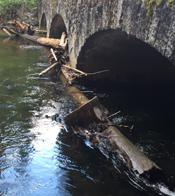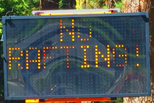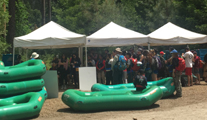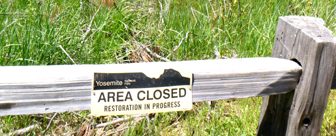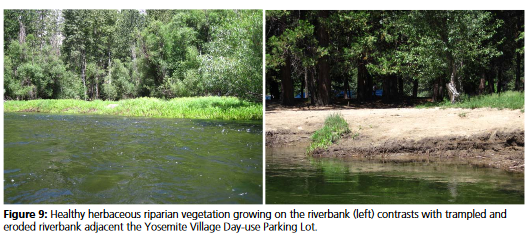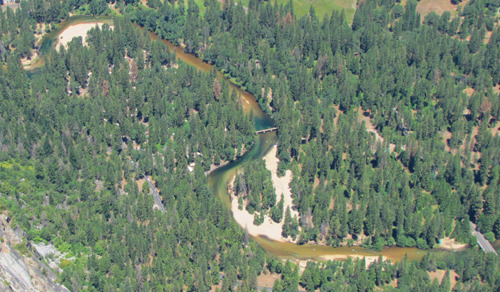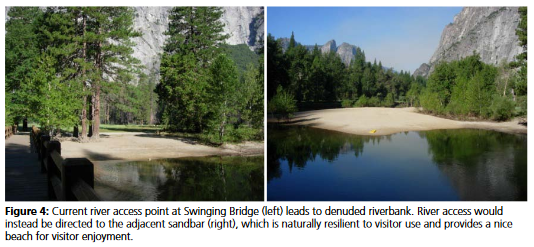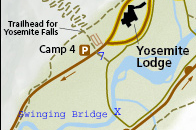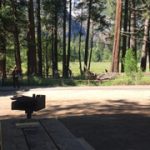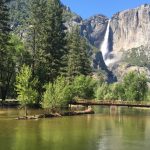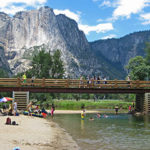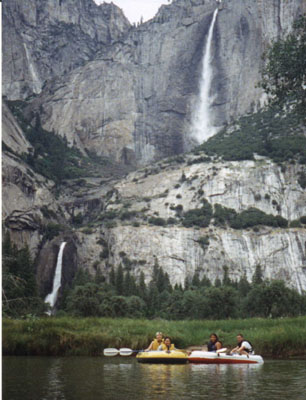
How cold is the water in the Merced River in Yosemite valley right now? Scroll down at:
https://waterdata.usgs.gov/nwis/uv/?site_no=11264500
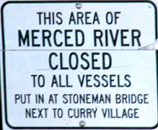 The website has said: “Rafting is permitted on the Merced River between Stoneman Bridge (near Half Dome Village AKA Curry Village) and Sentinel Beach Picnic Area between 10 am and 6 pm.” “The entire length of the Merced River is closed to all flotation devices whenever the river gauge at Sentinal Bridge reads 6.5 feet or higher or the combination of air and water temperature is less than 100 degrees Fahrenheit.”
The website has said: “Rafting is permitted on the Merced River between Stoneman Bridge (near Half Dome Village AKA Curry Village) and Sentinel Beach Picnic Area between 10 am and 6 pm.” “The entire length of the Merced River is closed to all flotation devices whenever the river gauge at Sentinal Bridge reads 6.5 feet or higher or the combination of air and water temperature is less than 100 degrees Fahrenheit.”
As of spring 2016, it changed and rafters could launch further up river, as of July 2017, the legal launch point was back to Stoneman Bridge. It can change each season.
Below, a May 2018 photo of multiple tree trunks wedged against the Ahwahnee Bridge, a good reason to NOT launch from the campgrounds / Ahwahnee Hotel and expect to safely go down river:
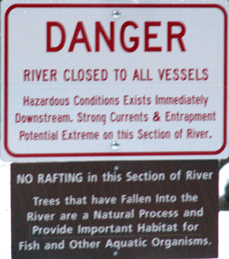
Many years it says the river is open for rafting “when the gage height at Pohono Bridge is below 7 feet at 8 am.” and on another page it said “Launching and retrieving boats is permitted only at the following locations:
The area downstream from Clark’s Bridge for approximately 100 feet, or as signed
The area downstream from Stoneman Bridge for approximately 100 feet, or as signed
The sandy, unvegetated area of Sentinel Beach. . .”
Please check the current rules before you go to the park and again before you launch, https://www.nps.gov/yose/planyourvisit/boating.htm
As of summer 2020, the park said this about lifejackets:
“Personal flotation devices required
Every occupant of a boat, raft, or inflatable must wear a personal flotation device each day when the gage height at Pohono Bridge is above 4 feet at 8 am. When the river is 4 feet or lower, every person must have a personal flotation device immediately available for each occupant of the raft/boat (and children under age 13 must be wearing one).”
Please also read Floating the Merced – A Tale of Three Search And Rescues, at the end of this page for the reasons private rafters should also launch where the commercial rafts launch.
If you bring your own raft you must wear or (sometimes) have a U.S. Coast Guard approved personal flotation device immediately available. (But if you are wise you will all be wearing your securely fitted, fully zipped lifejackets no matter how high or low the river water is.)
Rental rafts rules include everyone, adult and child, wearing their lifejacket. The rental company warns that rafting is not recommended for non-swimmers.
If you want to raft you should check for the current rules when you arrive in the park. You might find them in the Yosemite Guide newspaper, or by asking at a Visitor Center. Or try the Index to over a dozen park webpages with park laws, rules, regulations, policies and prohibitions about rafting, pets, bikes, permits, campground regulations, food storage, smoking, speed limits . . . and much more.
Rentals at or near Curry Village (briefly named Half Dome Village) are usually from 10 a.m. to 4 p.m. -last return shuttle leaves at 6 p.m. ” A typical season begins the last weekend in May and ends in July” but some years the water level will be too high to get under bridges until late June. Even then rafting might not be open all day, but will not open until the afternoon each day that it does open. Some years the season can start earlier, even in mid April, but perhaps on weekends only at first. (Lots of water in 2017 meant that raft rentals extended through September 4. In 2025 “Due to the low water levels the last day to rent rafts from Curry Village will be this Wednesday June 25th.”)
The rental rafts page will usually say whether rafting is currently open.
Or you might see a warning sign with flashing messages on your drive into Yosemite Valley:
The park service limits the total number of rafts rented each day and the number of rental rafts on the river at any time is limited. You can get a reservation at the Curry Village (briefly named Half Dome Village) rental stand near free Yosemite Valley shuttle bus stop #14. Guests at Curry Village and people who are not guests at Curry Village can book a tour, pay to rent a bike or a raft, or pay for ice rink use/ skate rental at the little Tour Kiosk between the front office and Stoneman Cottage.
Usually at least 80% of the rental rafts reserve the day before. The concessionaire has said: “To receive a full refund, cancellations must be made at least 2 hours before the scheduled session. Cancellations made within 2 hours are nonrefundable.”
Most people take two hours for one trip, but if you dawdle or stop and swim/picnic you can take a half day or more. If you try to fit in one extra run at the end of the day and you actually paddle you can do it in 35-45 minutes. (But rental rafts are limited to one trip down the river.)
How much you pay varies greatly.
You can pay the concessionaire to use a “paddle-yourself” raft that holds 2 to 4 people,
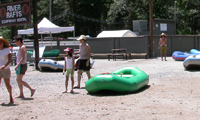
carry it to the launch point, go three miles down the river from Curry Village and get a ride on a tram back to where you started from. The rentals pickup and carry location can change from year to year.
You may have to wait awhile for the shuttle ride back. If you want to ride again that day you have to pay again. The concessionaire’s website (2024 and 2025) quoted $32.50 per person, (2022) quoted $30.50 per person, (2019) quoted $28.50 per person, (2018) quoted $27.50 per person, (2016) quoted $31 per person, which later changed to $29.50, which stayed as the price in spring 2017. A child must weigh at least 50 lbs. The release form/website has said, in part, that two ‘capable’ paddlers, at least 5 feet tall and 12 years old are required for each rental raft. An adult is required in each boat.
Investigate the costs for yourself: the cost for a family of four rafting twice on one vacation compares to buying their own raft, paddles and lifejackets for each rafter.
Again, the rentals website says “a typical (rental) season begins the last weekend in May” (early June many years) “and ends sometime in July.” But people with their own gear can sometimes float along parts of the river (and wade, pulling a raft by a short rope through shallow parts) weeks longer into the summer after raft rentals have stopped.
Many people buy just an inner tube, a small raft, inflatable shark or even a wading pool and float in one area all day. (There are no inner tube rentals in Yosemite but if you forgot your lifejacket you can rent a lifejacket, 2024 and 2025 $5.75 and paddles for $5.25. Others float a small way down the river and paddle back up or walk on a path back up and start again.
Others with their own equipment float the whole distance the concessioner rented rafts go, and pay a small fee: 2024 and 2025 $5.25 per person to get a ride back on the concessioner’s shuttle. (Your deflated raft/inner tube must fit on your lap to use the pay shuttle.)
Some groups with their own rafts drive two cars to the end of the route and then bring one back to the start, do their rafting and drive back. This method brings even more traffic on the congested roads, (and such rafters can be stuck in that traffic in the process) creates unnecessary pollution and they might not find any parking at the end of the route.
In our group we raft for almost all of the route, get a free bus ride back to the start, and go again, sometimes many times all day. Here’s how we do it:
1) We bought our own rafts, paddles and lifejackets. (Do we need to mention only non-motorized rafts are allowed? We never raft barefoot.)
2) We pack our uninflated rafts and other gear in big duffle bags or a huge backpack (sometimes we wear our lifejackets on the bus so we have less to tote, and yes, all the adults wear their lifejackets) and take the free Valley shuttle bus to Curry Village stop 14 and walk to the Stoneman Bridge launch point.
(There used to be a fairly close bus stop to the launch point, but in May 2022 the routes changed.)
Info about the shuttle bus route, stops and schedule is at: Yosemite Valley free shuttle bus
For many years you could inflate your raft using an electric air pump set up just outside the raft rentals area. It’s the orange item in the green box in this photo. But in 2011 they decided to not let the public use any of their equipment to inflate rafts, so you will need your own raft pump.
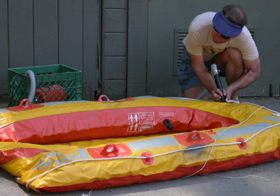
OR we sometimes inflate the rafts where we are staying and bungee-cord them to a small, fold-up, wheeled airport-style luggage cart and wheel them to the launch area.
We always bring a hand pump along in case we need to re-inflate the raft as we float.
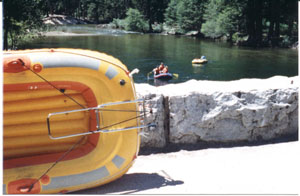
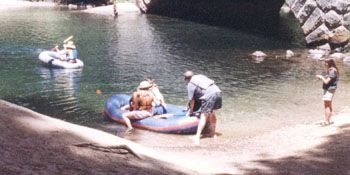
Most years the current at the Stoneman Bridge entry point wants to bring you quickly to the far side of the river, and sometimes under some overhanging tree branches, so act accordingly.
Here, a view of Stoneman bridge, the river downstream of it, and Half Dome:
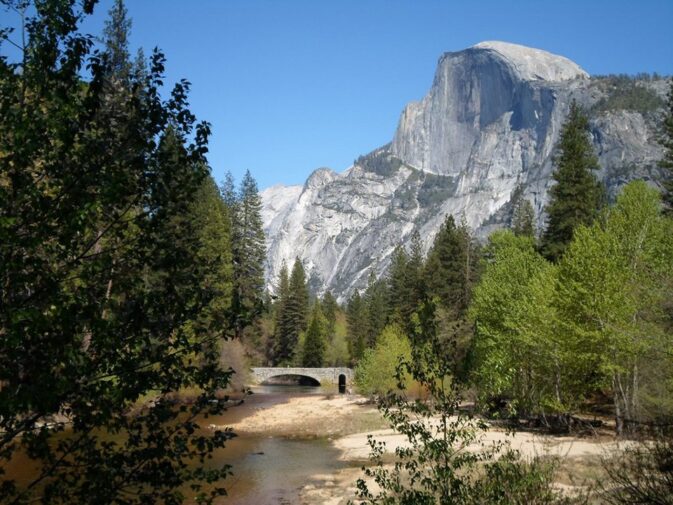
Also note this from the rentals website:
“Rafters are not allowed to land on riverbanks (even if the banks are sand or gravel), except at Stoneman Bridge and Sentinel Beach…
Be cautious and alert! Trees and rocks do exist in the Merced River, creating obstacles requiring your attention. Rafts may not be tied together.”
Parts of the riverbanks are lush with pants, but many sections are worn out. Along with requiring that people in rafts not land on riverbanks, the park service is putting more low fencing to keep people from walking everywhere and wearing out that plants and stepping on the wildflowers.
Below is a photo, taken from Glacier Point, with the launch point area, Stoneman Bridge, in the lower right hand corner of the photo and the Merced River flowing around Housekeeping Camp, mostly on the left hand side of the photo, along with beaches at the camp and across the river from the camp. The pedestrian bridge in the center of the photo, from Housekeeping Camp to the beaches, will be the first bridge rafters must negotiate going under.
Google street 360 degree photo view of the pedestrian bridge and the beach on the far side of the river from Housekeeping Camp. Read more about Housekeeping Camp and other Yosemite valley overnight accommodations here.
3) We float down as far as the pedestrian bridge south of Yosemite Lodge (Swinging Bridge on some maps) and deflate the raft in the water and pack it up in it’s bag the water so we are not dragging it up on the shore and potentially damaging plants. (Again, starting in 2016/2017 the rules say you can’t launch/land everywhere: “You may not take out your raft between Stoneman Bridge and Sentinel Beach.”)
Then sometimes we hang out and swim/picnic. (Please read safety advice below at the Swimming in the Merced river in Yosemite Valley section.)
As a part of the Merced River Plan, at Swinging Bridge the park service will be trying to let the overly-used parts of the riverbank on the upstream side of the bridge grow back and encourage people to use the sandy beach on the downstream side of the bridge:
Eventually we walk north on the paved scenic path along the edge of Leidig meadow to free shuttle bus stop #7 at the east end of the Yosemite Lodge buildings. We use a small, fold-up, wheeled airport-style luggage cart to trundle the gear.
We pack the luggage carrier into its cloth bag, and put it into a raft duffle bag. No, you can’t bring an inflated or even partially inflated raft on the bus. It’s too big to fit down the aisle and it’s wet, sandy and or dirty and gets others on the bus dirty. Either sew a large drawstring bag or buy a duffle bag or large backpack big enough to fit each fully deflated raft in. It won’t be much bigger than a big backpack that others might be carrying on the bus. As of 2016 a rule said it is okay to have a deflated raft/inner tube, etc. on the bus if it fits on your lap.
Because people were not careful that their paddles didn’t hit people, loose paddles are not usually allowed on the bus, so make a bag for them as well. Many kinds have blades that unscrew from the shaft and/or shafts that divide into two parts make them an easier fit in a bag.
We are quite polite and are sure to dry off enough, (we mostly drip dry as we walk to the shuttle bus stop), that we won’t get people on the bus wet. If we are too damp, we don’t sit on a seat and leave a puddle, we stand instead. Then we ride back to the launch point and start again, or ride back to our campsite.
Restrooms on the route are: At the launch site, walk south across Southside Drive to the Curry Village vicinity of the parking lot for the winter ice rink. There are more restrooms at Housekeeping Camp on your left as you paddle. Restrooms are also on the left side of the river as you approach Swinging Bridge picnic area (also charcoal grates and picnic tables) but again you can’t launch/land everywhere, and some years the rules say/said: “You may not take out your raft between Stoneman Bridge and Sentinel Beach,” so someone will need to stay with the raft in the water and back paddle if people need to get out and use the restrooms at Housekeeping or Swinging Bridge. Again, please check when you get to the park what the current rules are.
HEY- don’t tie rafts together. You might think it’s safer, but the second or third raft can get caught in bushes and make all of them turn over, or the first one or two can go under a bridge safely, but the second or third can get pulled along at the wrong angle and end up running into or firmly catching on a bridge abutment, spilling the people in it into the river or worse. (We’ve seen this happen!)
Don’t try to stand up in your raft or lean over the side.
From the National Park Service Morning Report
Monday, August 09, 2004
Saint Croix National Scenic River (WI)
Two Drownings in St. Croix River
“… rangers responded to another drowning in the river, this time near the Osceola day use area. Ronald Butcher, 39, was floating on a raft on the river with his wife and 13-year-old son when a rope attached from an inner tube (with cooler) to his ankle snagged on a submerged log and pulled him under. Several other people also floating on rafts in the area tried to locate and assist Butcher, but the swift current prevented them for doing so. The Osceola (Wisconsin) Volunteer Fire Department and St. Croix District rangers managed to locate and bring Butcher to the surface within 15 minutes. CPR was immediately begun. Butcher was transported by boat and ambulance to the Osceola Medical Center, where he was pronounced dead after continued life saving efforts failed. Sergeant Butcher, known to many of the St. Croix District rangers, was a 13-year veteran of the Chisago County (Minnesota) Sheriffs Department.”
[Submitted by Brian R. Adams, Chief Resource Protection]
Many of the bridges in Yosemite Valley have signs on them in a position rafters can see, saying which part of a bridge to go under. Sometimes the current is tricky and you want to be far to the right or left. If there is no sign, you might still want to go to the side because some kids jump illegally off the bridges, and some actually aim to land in the water very near rafters.
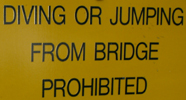 (Yes, there is an actual Yosemite regulation: “Jumping or diving from any bridge is prohibited… This activity has resulted in severe injuries to persons who have jumped from bridges into shallow water. Also, people jumping from bridges cause increased water turbidity and shock waves, both of which have a detrimental effect on fish and other components of aquatic ecosystems.”) Another reason to discourage your group from jumping is that they are role models for others. They might be good enough at jumping to not slip and hit their tailbone or the back of their head on the bridge as they jump, but a child who sees them and tries it might not be.
(Yes, there is an actual Yosemite regulation: “Jumping or diving from any bridge is prohibited… This activity has resulted in severe injuries to persons who have jumped from bridges into shallow water. Also, people jumping from bridges cause increased water turbidity and shock waves, both of which have a detrimental effect on fish and other components of aquatic ecosystems.”) Another reason to discourage your group from jumping is that they are role models for others. They might be good enough at jumping to not slip and hit their tailbone or the back of their head on the bridge as they jump, but a child who sees them and tries it might not be.
There are also signs and bouys marking branches of the river that are closed to rafters, as in the photo below:
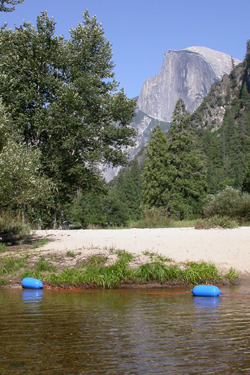
In general, as you go along a big curve in the river, the river will try to push you into the bank, so watch the rafts in front of you to see where they are pushed. You may need to paddle hard to keep from the bank. Some places it’s wise to pause for awhile and watch a few rafts, especially where the river splits up into many channels going around various islands. Then you can keep from ending up stuck in bushes.
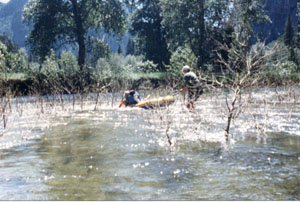
Stay upstream of any craft you are trying to dislodge from bushes or rocks so when you get it loose it doesn’t hit you or knock you over!
Sometimes (rarely) is isn’t safe to go after a stuck raft or other craft and it should just be left until the water level on the river drops, such as the NPS photo below of a kayak stuck in the branches of a submerged tree in a section of the Merced river not truly safe for boating
(The NPS picture below is from Floating the Merced, a Tale of Three Search and Rescues.)
Yosemite whitewater rafting trips you see advertised are outside of the park and will not have the same views as this valley rafting route.
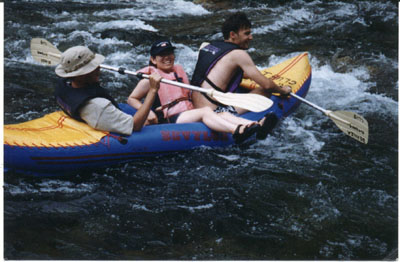
When you enter and exit the river please note that the bottom rocks can be very slick, and the current can be stronger than you think, watch your step.
Teton County (Wyoming) Search and rescue would like you to know:
“Do not stand in moving water, even if shallow. If your foot gets trapped in the rocks, the current will push you over, wedging you foot tighter, and pushing your head underwater. You will drown. Others have drowned in 2 feet of water this way.”
Swinging Bridge where we stop rafting, and pack up our gear and walk alongside a huge meadow to free shuttle bus stop #7, has a good swimming area (in season) with shallow and deep water and sandy beaches. Across the bridge is a large picnic area with tables, grills and accessible vault toilets.
(Most places along the river in Yosemite valley are not at all safe for swimming, even if you keep your children within arms reach. https://www.nps.gov/yose/planyourvisit/watersafety.htm)
Even though it can be safe to swim at Swinging Bridge, this happened to non-swimmers at this favorite Yosemite Valley river swim area:
“Near Drowning at Swinging Bridge
July 4, 2014 Posted by: Yosemite Search and Rescue at their Lessons From The Field webpage
On the Fourth of July, the parents of a six-year-old girl brought their daughter to the Yosemite Medical Clinic after she nearly drowned in the Merced River. The parents recounted the following story to clinic staff:
Along with her parents and seven-year-old sister, the six-year-old subject was wading in a shallow area of the river, just below Swinging Bridge. The subject’s parents don’t know how it happened, but all of a sudden they saw the subject slipping below the water in what turned out to be a deep section of the river; the last they saw of their daughter was one of her hands reaching skyward before it disappeared. The mother and then the father, both fully clothed, jumped into the water at the spot they last saw their daughter. Neither parent knows how to swim, so they also sank to the bottom of the river. A bystander, watching what had just happened, jumped off the bridge into the river, and with one arm grabbed the six-year-old subject, while with the other arm he pushed the father, who in turn pushed against the mother, up and out of the water. Other bystanders helped the parents out of the water, while the original bystander carried the subject out of the water. The subject never lost consciousness and reported to clinic staff that she remembered the entire episode. The parents estimate she was submerged under the water for 1-2 minutes. After she was rescued, the subject was coughing persistently, but was able to breathe on her own.
About an hour after the near-drowning episode, the subject complained of a stomach ache and vomited multiple times; her parents brought her to the clinic for further evaluation. After consulting with Children’s Hospital Central California, the clinicians at the Yosemite Medical Clinic advised the subject’s parents to have her transported by ambulance to Children’s Hospital for more extensive evaluation and overnight observation.
Submersion injuries can present in a variety of ways. The victim can be completely unresponsive and pulseless or can be awake and oriented and seemingly unscathed. It is worth noting that even subjects without any symptoms that suffer near drowning can still decompensate into respiratory failure up to 8 hours after the injury. It is therefore essential that all near-drowning victims receive further medical assessment.
It is imperative for those playing in and near water in Yosemite to understand that drowning incidents occur not only in fast moving white water, but also in shallow, slow, seemingly benign bodies of water as well. This is particularly true for young children and those who do not know how to swim. According to the Centers for Disease Control (CDC), every day in the United States, ten people die from unintentional drowning. Of these ten, two are aged 14 and younger. Children ages 1 to 4 have the highest drowning rates. Research has shown that both lack of swimming ability and lack of close supervision influence drowning risk.
One drowning prevention strategy that is particularly important in Yosemite is close supervision of children when they are in and around rivers and lakes. The CDC recommends that “because drowning occurs quickly and quietly, adults should not be involved in any other distracting activity…while supervising children…” It is worth noting that the adult responsible for the supervision of the child should be comfortable and capable of swimming him or herself. The supervisors of young children should provide “touch supervision,” close enough to touch or reach the child at all times.
Learning to swim is another drowning prevention strategy that is important for both children and adults. If you are planning to vacation in an area with pools, lakes, rivers, or ocean, please consider enrolling you and/or your child in beginner’s swimming lessons. Most local pools, YMCAs, and American Red Cross chapters offer local swimming, first aid, and CPR classes. Visit your city or town’s official website to find out where you can participate in swimming lessons in your area. It could save a life!”
Please read swimming in Yosemite National park
_______________________________________________________
The Red Cross book Small Craft Safety has these notes about
what to do if you fall into moving water from a raft:
“Capsizes, falls overboard and collisions are common paddling accidents in moving water. If your boat capsizes or you fall overboard into moving water-
1) float downstream on your back with your feet in front of you. This will help you fend off rocks and avoid trapping your feet.”
(Can you see your toes? If not, your legs are too low in the water and you risk getting your legs stuck.)
“2) Swim toward shore or into an eddy” … “(the sheltered area behind or downstream of an obstruction, where the currents flow upstream toward the obstruction)” …”as soon as it is safe to do so. If you are close to shore, if the water is cold, or if there are hazards further downstream, consider swimming toward shore.
–In shallow water, swim on your back at an angle against the current and toward shore.
–In deep water, swim on your front at an angle against the current and toward shore.
3) Do not stand up, you could catch your foot at an angle under a rock and become entrapped and pinned, even in just a few feet of water.
4) If necessary or practical, hold on to the craft for flotation
–hold on to a grab loop” (or other rope built into the raft), “keeping the craft in front of you.
–stay on the upstream end of the craft to avoid being caught between the craft and a rock.
–try to swim with the craft toward shore or into an eddy as soon as possible
–if necessary, let go of the craft and swim for shore.”

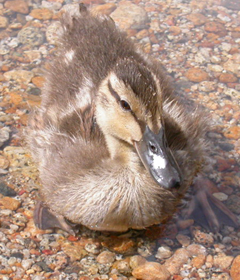
HERE’S OUR LIST OF STUFF WE PACK TO RAFT:
Various rafts (four person rafts are most comfortable for only two people and some gear) and a duffle bag/big backpack for each raft with room for extra stuff. We carry a small repair kit. Paddles for steering, backpaddling. A duffle bag for the paddles.
Fold-up luggage cart in its own cloth bag so it can’t puncture a raft; bungee cords to attach things to it.
Some 3 foot cord to tie to the raft to be able to drag it though any walking depth portions of the river, especially late season when the rentals have stopped for lack of depth. This can be a great time to raft, because there are stretches of the river with no people. We see more deer near dusk. Floating on the river, even if you have to wade a lot, (hey, not with bare feet) is a great way to sightsee when August has temperatures in the 90s.
Lifejackets on everybody. Yes, we wear the lifejackets, because some of us are Red Cross certified lifeguard instructors and we have respect for the power of water, even on a fairly gentle river stretch like that in Yosemite Valley. Plus we found it easier one summer to rescue a small child overturned from a raft because we had lifejackets on (the screaming child and screaming parents didn’t).
Hand-powered pump for inflation and re-inflation; Ahwahnee Hotel room service coffee-stirrers to hold the raft valves open to deflate them.
Towels in a waterproof bag. We own real drybags and have never regretted the extra expense, but you can use strong plastic bags. Trash compactor bags are 3 mil and will hold up longer than other, lighter plastic bags.
A waterproof camera (most of these float). If you raft in a group you can paddle slowly or paddle/backpaddle to hold your place on the river while your friends float by and get pictures of each others’ rafts with Yosemite Falls or Half Dome in the background.
In the afternoon you may see deer along/in the river or meadows. If you are really careful you can videotape this adventure, but have a dry bag to quickly stash the camera in if trouble occurs. Decades ago we risked getting binoculars wet, then we bought waterproof ones and attached a few floats to them in case we were to drop them in the water.
A topographical map to identify sights. (Or the “Map and Guide to Yosemite Valley” published by the Park and the Yosemite Assn.). Or at least a shuttle bus map to find your way to free bus stops.
Mini ice chest, preferably with a lid that locks in some way, with an extravagant picnic. HEY- don’t bring any Styrofoam ice chests!! In an accident they break up and leave bits of Styrofoam all over the river. It’s always uncool to use glass containers rafting, poolside or on any beach because people are often barefoot and don’t want cut feet from broken glass. Possession of a glass container within 50 feet of any riverbank, lakeshore, on the water or in a vessel is prohibited by Yosemite rules.
We put on sunscreen before we go to the river so we won’t forget to use it and we bring extra. The sun reflects off the water, so you’ll need some on the underside of your chin and the underside and maybe even just up into your nose, just like you need when you’re out in the snow all day. If you wear Tevas you will need some on top of your feet. Don’t wreck the rest of your vacation by failing to use strong, really waterproof sunscreen. SPF 5 is a joke.
We use 36 SPF or stronger. Most brands need to be put on a half hour before swimming or they will wash right off and make an oil slick on the river. (‘Kids’ sunscreens often are overly scented and will attract mosquitoes.) If you try a new brand, test a little on a small area of skin in case it turns out you are allergic. Our group jokes that two ways to tell an amateur who wasn’t prepared for a trip to Yosemite are peeling sunburn and people wearing Yosemite logo rain ponchos.
There’s advice at insect repellant.
We wear swimsuits under shorts and shirts. We bring polypropylene long sleeve shirts, the kind you wear under everything else winter camping, for warmth in case we stay wet and out too long and get cold. Cotton is the wrong thing to get warm in or stay warm in when you are damp or wet.
Rarely you might wish you had your rain jacket, maybe not for light rain (you’re wet already anyway), but for afternoon hail on the walk to the bus. (Yes, a real possibility.)
Something to tie back or braid long hair. A hat with a brim for sun protection or to keep low-angled afternoon sun from your eyes, with a strap or clip to your hair for afternoon wind.
Old tennis shoes or rubber type sandals that velcro all the way around your ankles to stay on your feet. You can’t swim well with them, but for launching, wading, portaging, and walking to the bus stops they beat the risk of cut feet. NOT flip flops!
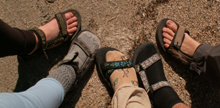
When the water level is low and you have to carry your raft part of the route you’ll be glad you had shoes on.
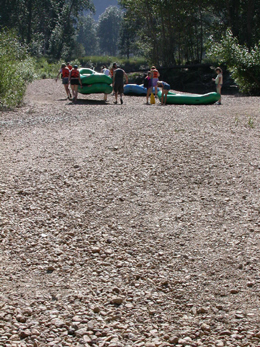
24 hours a day have a whistle on each person and a first aid kit. While kayaking don’t have your whistle on a string around your neck, tie it to the lifejacket you are wearing.
A quart size plastic bag for trash you pluck out of the river or find along the bank. Bigger items like a lost tennis shoe or discarded water bottle can be stashed in the raft.
Secure your car keys, credit cards, etc. carefully so you can’t lose them in the river. Yes, I know you don’t need money with you while you are rafting, but your route back from rafting to your overnight accommodations might take you by some ♥ ice cream bars or another necessity and you could wish you had a little cash.
Water purifying pump and see the list of day hike or kayak gear at: Camping equipment checklist
Hey! Personal headphone radios and tape players are so much less rude than a boombox.
Give your neighbors who are rafting or at picnic areas and campsites a break.
The 2003 release form from the concessionaire said, in part “Certain risks cannot be eliminated without destroying the unique character of this activity. The same elements that contribute to the unique character of this activity can be causes of loss or damage to your equipment, or accidental injury, illness or in extreme cases, permanent trauma or death. We do not want to frighten you or reduce your enthusiasm for this activity, but we do think it is important for you to know in advance what to expect and to be informed of the inherent risks. The following describes some, but not all, of those risks: Rocks, trees, river currents, cold water, hypothermia, submerged objects, changing weather conditions, drowning, capsizing or collisions, and damage to personal property.”
The Yosemite park website has safety notes about rafting and swimming at:
http://www.nps.gov/yose/planyourvisit/safety.htm
Some flowers along the way: (for weeks around the summer solstice there are a few azaleas so fragrant you can smell them as you float by them):
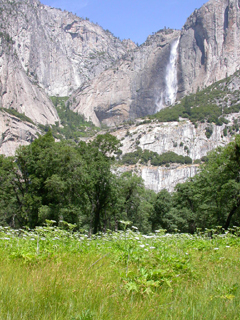

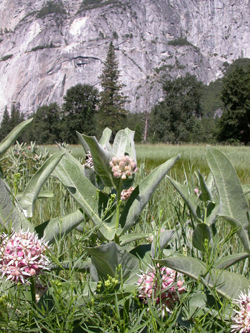
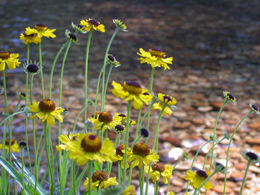


Common Yosemite Wildflowers
Especially if you’ve never been to Yosemite, the Yosemite Guide newspaper has lots of safety info, a calendar of park activities including Ranger walks, and hours of operation for visitor centers and museums.
It has hours of operation for tours, stores, food service, post offices, laundromat, showers, auto service, gas stations and more. It usually has detailed maps of the exact locations of stores, etc. at Wawona, Tuolumne Meadows, Curry Village, Yosemite Village and Yosemite Lodge.
https://www.nps.gov/yose/planyourvisit/guide.htm

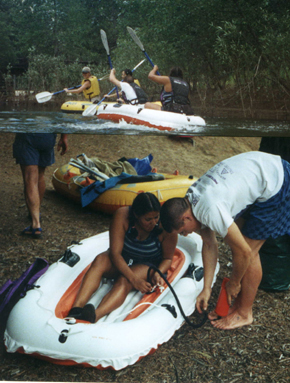
Why can’t you swim during a lightning storm? A strike on a lake doesn’t kill all the fish in the lake.
We can find the answer from the Charolotte observer Posted on Sat, May. 31, 2003
GLAD YOU ASKED
Why don’t fish get fried by lightning?
JEFF ELDER
“Q. They always urge you to get out of the water when a thunderstorm begins. Why doesn’t lightning kill fish? — Mel Helms, Charlotte
“…The best answer to Mel’s question we found comes from Don MacGorman, a physicist at the National Severe Storms Laboratory in Norman, Okla. When Sciencenetlinks.com asked him why fish don’t get fried by lightning, Don said it’s probably because they’re underwater.
“Basically lightning stays more on the surface of the water rather than penetrating it. That’s because water is a reasonably good conductor, and a good conductor keeps most of the current on the surface,” he said.
So, when lightning hits the water, the current zips across the surface in all directions. And if you’re swimming anywhere in the vicinity, it’ll probably zap you. But below the surface, most of the electricity is neutralized, and the fish are generally spared. Some fish underwater near the strike are probably hurt or killed by electricity that penetrates to some extent…
Why you should wear a lifejacket
https://www.nps.gov/yose/learn/management/upload/Recreation-study-full-report-July-2012.pdf
In it we find that peak river use levels are between 3 and 4 p.m. (less after 5 p.m) and that rental boats make up 60% – 70% of river use. Over 60 percent of visitors supported rafters being required to wear lifejackets (PFDs)”Current California law requires boaters to have PFDs available in their boats, but they are not required to wear them.” Very few supported ending rafting or limiting the number of rafts rented.
Cover photo of a beach at Housekeeping camp from the study:
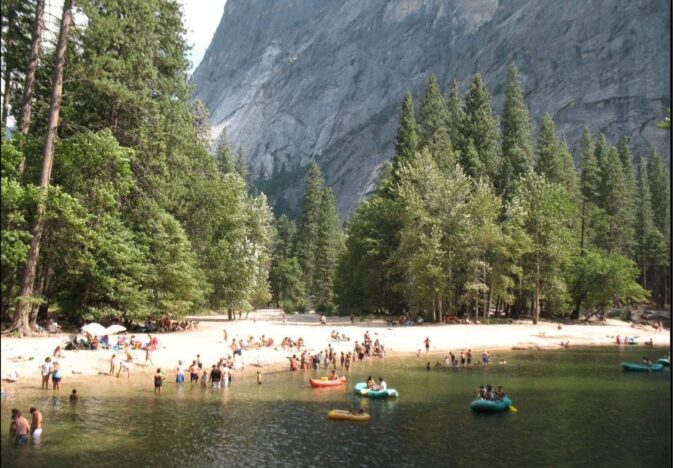
https://www.nps.gov/yose/planyourvisit/watersafety.htm
June 12, 2016, Posted by: Yosemite Search and Rescue
(read the entire blog post at: https://www.nps.gov/yose/blogs/Floating-the-Merced-A-Tale-of-Three-SARs.htm )
. . . #1 – Near North Pines Campground (above Stoneman Bridge) a young male and female adult in an inflatable raft are unable to negotiate obstacles in heavy current and collide with a tree. Neither have personal floatation devices (PFDs), aka “life jackets.” They scramble up the tree and await rescue.
#2 – A 60 year-old male unties his inflatable raft from a group of other rafts. Although he recently inflated his raft, it is now roughly half deflated which affects its buoyancy and maneuverability. He misses the take-out point, ditches his raft, and tries to swim to shore. He is not wearing a PFD. He is able to grab a buoy and a companion is briefly able to assist him. When he tries to stand, the combination of poor footing and strong current carries him downstream and he disappears. An active search is underway as of this writing.
#3 – A solo young male in an inflatable raft near North Pines Campground is not able to negotiate obstacles in the heavy current. His raft passes through a strainer (a cluster of branches in the river). The strainer separates him from his raft which he is able to grab on the other side of the strainer. He then grabs a tree which he scrambles up and awaits rescue. He is wearing a PFD but rescuers note it is not properly buckled but it is not known if this is the result of passing through the strainer. Rafting in an area of the river which is not open to rafting has dangerous rapids as well as trees and other obstacles. After being rescued the young man is issued a violation notice for rafting in a closed area.
What Went Right
In the two successful SARs, all three persons remained calm and stayed in place to await professional rescue.
Lessons Learned
Do some planning and research before leaving home. What are current river conditions? Where are there hazards to avoid? What type of equipment is suitable for these conditions? What are the local legal requirements? (Please see https://www.nps.gov/yose/planyourvisit/boating.htm). In all three cases, the rafts in use were probably not of a suitable quality for current Merced River conditions. While we make no brand recommendations, it is suggested that persons wanting to float any river consult with a reputable outfitter who is knowledgeable about river recreation and can recommend a proper watercraft for such conditions. The old adage is often true: “you get what you pay for.” Are you ready to put your life into it?
Always wear a properly fitted and serviceable PFD on the river – we do. Anyone 18 and older floating the Merced is required to have a Coast Guard PFD immediately available (under 18 must wear their PFD). This is a fairly universal boating requirement. However, occupants of large vessels almost always have time to obtain an “immediately available” PFD if something starts to go wrong or conditions change. This is rarely the case where swift water is involved because mishaps occur very quickly.
Stick to the commercially approved area of the Merced River: Stoneman Bridge to Sentinel Beach. The river is currently about class 1 or class 2 in this area, but above and below are up to class 3, class 4, and higher. Obstacles are also more prevalent outside of the commercial area. When looking for a place to float and you notice your area of the river is nearly abandoned while other parts of the river are full of rafters, ask yourself, “is something unsafe about this section of the river?”
Boat with companions. There is greater safety in numbers.
Strongly consider a wetsuit. The water flowing through Yosemite Valley is recent snowmelt and can be anywhere between 40° and 50° Fahrenheit (http://waterdata.usgs.gov/nwis/uv/?site_no=11264500). Sudden immersions will cause cold-shock and hypothermia can set in rapidly.
In summary, the Merced River is currently providing opportunity for recreation. However, no one should attempt river recreation unless they are well versed in its hazards including its powerful currents, cold water temperatures, entrapments and other dangers. Combine these natural conditions with lack of planning or experience and unsuitable watercraft or no equipment, and your day of river fun can quickly come to ruin.
Respect the river.”
Why you should wear a lifejacket.
——————————————————————-
The author of this webpage, (written as a reading assignment for my students), does not give any warranty, expressed or implied, nor assume any legal liability or responsibility for the accuracy, completeness, or usefulness of any information, product, or process included in this website or at websites linked to or from it. Users of information from this website assume all liability arising from such use.
